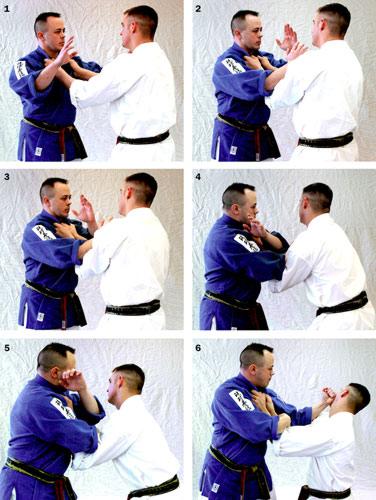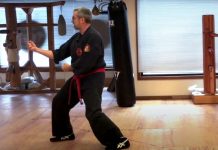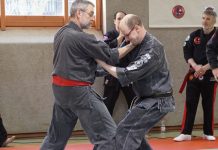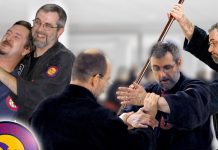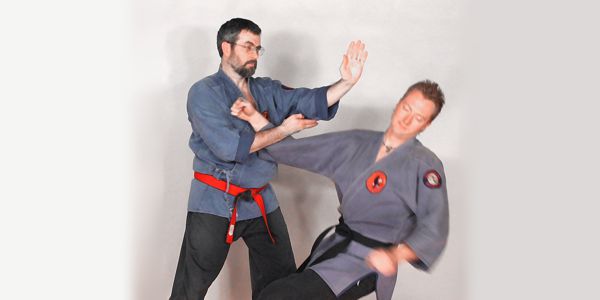 In the martial arts community, those who practice kyusho-jitsu (pressure-point techniques for fighting) are often subjected to criticism. It all started when their self-defense method was first brought into the limelight and onlookers didn’t even want to believe the techniques were real. Those days are long past, however, and the reality of pressure-point knockouts has been convincingly demonstrated time and time again—most notably by Black Belt Hall of Fame member George Dillman and his students.
In the martial arts community, those who practice kyusho-jitsu (pressure-point techniques for fighting) are often subjected to criticism. It all started when their self-defense method was first brought into the limelight and onlookers didn’t even want to believe the techniques were real. Those days are long past, however, and the reality of pressure-point knockouts has been convincingly demonstrated time and time again—most notably by Black Belt Hall of Fame member George Dillman and his students.
Nowadays, two main criticisms persist. The first consists of dire warnings that pressure point techniques are dangerous and that those who practice them by actually knocking each other out are reckless and foolhardy. As you’ll see, this accusation is groundless.
Dangerous Techniques?
For more than 20 years, the once-secret art of kyusho-jitsu has been publicly taught and demonstrated. Thousands of students now practice its methods, and an untold number of people have been knocked out, some on numerous occasions. In 1997 at the Hospital of the University of Pennsylvania in Philadelphia, a team of scientists sought to examine the mechanism behind pressure-point knockouts. In their findings—which were reported in Black Belt’s September 1998 issue and subsequently published in the Journal of Sports Medicine and Physical Fitness (1999; 39:328-335)—they stated that “… no hazardous complications were demonstrated and no immediately dangerous phenomena … were noted.”
Nonetheless, claims regarding the dangers of pressure-point techniques persist like urban legends. Yet no one seems to ask the most natural questions in the world: “Where are the bodies? Where are the legions of martial artists whose health has been ruined by these strikes?”
This response to the claims of associated dangers eliminates the need to address the issue by comparing pressure-point strikes to free sparring, yet it still should be done. In free sparring, martial artists regularly suffer damaged joints, concussions, broken bones and even occasional death—all while participating in “no-contact” sparring. When the action is intensified to the level of full-contact fighting or boxing, the potential for injury is even greater, yet few ever accuse practitioners of those sports of reckless disregard for others.
Let’s be honest: Despite the cautionary advice of those who don’t practice pressure-point fighting and really don’t know anything about it, there’s no evidence to support the persistent cry of “reckless and dangerous.”
Try, Try Again
The second criticism of kyusho-jitsu is that the pressure points that must be activated are too discreet to be used in actual fighting. Those who make this claim always preface it by admitting that the points are for real and that they actually work in demonstrations. But in real combat, they insist, it simply isn’t possible to hit those tiny targets.
Setting aside the fact that the whole point of training is to learn how to perform high-level tasks under stress, it must be acknowledged that it is difficult to accurately hit a small moving target. This point has been articulated in many ways, but one of the best versions is this: A brain surgeon can perform a delicate operation, but can he perform it while the patient is running around the room?
Such a pithy summation of the problem seems to end the discussion among those who have no knowledge base from which to respond. However, the pressure-point practitioner’s educated response is simply: “You’re right. If you want to perform brain surgery, you first have to strap down the patient.”
That statement leads to what might be called the thesis of kyusho-jitsu: If the opponent is unable to move, it’s a whole lot easier to hit a point on his body. So the first rule of the art is to aim for the points that aren’t moving because they’re the easiest to hit.
The second rule follows logically: Do something to make sure what you want to hit isn’t moving.
Into Action
Consider the following self-defense scenario: An irate assailant reaches out with his left hand, grabbing you by the right shoulder to stabilize his intended target. (This is how the engagement portion of many bar fights begins.) But the moment he grabs you, all the pressure points of his extended left arm are motionless and easy to hit—really easy to hit. Those areas should be the first targets for your response.
So, if you’re a kyusho-jitsu practitioner, you might employ the ever-so-mundane karate technique known as morote-uke, which would normally—and inaccurately—be called an “augmented block.”
Now, it’s important to be honest and admit that as the victim, you’re probably going to be caught off-guard. (Otherwise, you would have left the scene to avoid a physical confrontation.) As a result, when you’re grabbed, your hands will probably rise in a natural warding-off gesture, obstructing the attacker’s first punch. It’s likely that as he winds up his right fist to try again, your brain will catch up with the situation and your training will kick in.
Immediately, you slam your left forearm into the middle of his left forearm at a pressure point called LI-7/wenliu, pinning his left hand against your body. At the same time, you use your right fist to strike near his elbow, at a point called LI-10/shousanli. This action causes his right shoulder to turn back and away, and it makes his left arm fold.
The performance of morote-uke calls for one hand to be squeezed tightly against your torso, while the other hand strikes out. If you simply continue the energy of your strike through LI-10, pulling your right forearm against your body, the attacker will be trapped and helpless, with his head motionless and within easy reach of your left fist. A blow to S-5/daying will generally finish the altercation.
Lesson learned: Before striking to the head, which can be highly mobile and difficult to hit, trap and control the attacker so his body and pressure points are immobile.
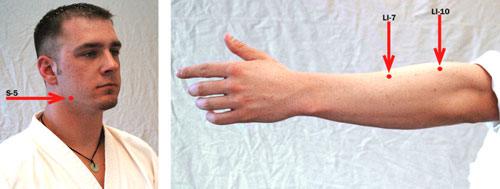
The S-5 point is on the side of the jaw. Right: The LI-7 and LI-10 points are on the outside of the forearm.
- The attacker uses his left hand to grab Dustin Seale by the lapel.
- A right punch to the head immediately follows, but the defender stops it with an instinctive warding-off gesture.
- As the attacker prepares to punch again, the defender strikes his forearm from two directions, smashing the LI-7 and LI-10 points
- and buckling his arm.
- Using his right arm to keep the opponent immobilized, the defender finishes with a left fist to the S-5 point on the jaw.
Up Close
In another example, again using morote-uke, the attacker grabs you with a two-handed lapel hold and pulls you in. This is a typical prelude to one of three actions by the attacker: a head butt, a knee to the groin or an attempt at some bad-breath-in-your-face intimidation. Of course, you have no idea which tactic he’ll use, so you must respond on the assumption that he intends to inflict bodily harm and not merely olfactory offense.
As you’re pulled forward, you borrow the attacker’s energy to move at a 45-degree angle. That takes you away from the line of his strength and places him in a somewhat awkward position.
At the same time, you strike inward, hitting his arms simultaneously on the LI-10 points on his forearms, causing them to collapse inward. Then, with one hand, you trap his arms against your body and use your other hand to strike the S-5 point on his head.
In both examples, hitting those “tiny targets” is extremely easy because you’re aiming for points that are immobile—immobile because of the actions you just took. And in both situations, the confrontation is in a self-defense setting, a real-life scenario and not a mutually agreed-upon match or some stylized one-step sparring drill involving a lunge punch delivered from across the room.
In both examples, the pressure point response is essentially the same, meaning you don’t have to stop and think about what to do under different circumstances. The scenarios demonstrate that pressure point fighting isn’t just about attacking points on the body. It’s about learning a comprehensive approach to self-defense and the traditional martial arts, one that takes into consideration the real dynamics of violent encounters.
Immobilization Is the Key to Making Pressure Point Techniques Work!

